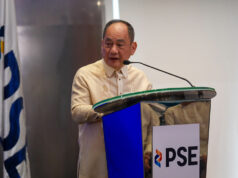Objects of antiquity unveiled to the public

An exhibit of a banker’s treasures launches Salcedo Auctions’ series of private art collections
FOR Edwin R. Bautista, the president and chief executive officer of UnionBank, anticipating the future is a priority. His job entails making decisions based on changing interest rates, economic growth, and the trajectory of banking amid the digital transformation.
But lining the hallways of his home and, more recently, in the exhibition space of Salcedo Auctions, is a vast array of battle-captured Philippine flags, indigenous and Katipunan-related armaments, and wood, ivory, and silver statues of saints made by local artisans — proof that he is just as concerned with the country’s past as he is with the future.
Among this varied collection is a trove of pre-colonial gold jewelry from Butuan and Samar, which are traces of a lavish lifestyle before the arrival of the Spaniards (and even before the concept of the Philippines arose). These particular objects of antiquity in the collection are prized, not just by Mr. Bautista, but by his wife Aileen, who beams with pride at the thought of Filipinos today realizing how rich their ancestors were.
The image many people have of an art or artefact collector is of a selfish greedy snob who cares mainly about the investment value of their possessions and the sense of prestige that comes with it. As passionate collectors, the Bautistas could not be further away from that caricature.
They like to share their collection with others. For example, many of the weapons in the collection were previously exhibited at the Museo ng Kaalamang Katutubo. This time, having them displayed at Salcedo Auctions in conjunction with the rest of the extensive Bautista collection is an overwhelming yet fascinating crash course in Philippine history.
Curated by director and art enthusiast Floy Quintos, the assortment of artefacts was organized to present many narratives of Filipino nationhood, as dense and varied as they are. It’s a big task that resulted in an exhibition that deserves to be seen by many beyond its one-weekend run at the start of September. For now, it has opened a Pandora’s box — with Salcedo Auctions taking on a new role, of unveiling private collectors’ prized possessions to the public.
“These are not just investments. These are about the learnings,” Mr. Bautista says, as he showed the guests his archive of rare maps hanging on the walls and tracing the emergence of the Philippines on the world stage from one old relic to another. Of great interest was a map from 1563, believed to be the first to mention the word “Filipinas,” hence regarded as the country’s birth certificate.
There was also ecclesiastical art, ranging from majestic santos to intricately painted retablos that represent Filipinos’ unwavering Catholic devotion. On the other hand, there was a subsection dedicated to anting-antings and mamarrachos, which are folk artefacts and icons that counter typical religious expressions with unorthodox portrayals of holy persons — a form of resistance by local artisans.
Seeing the creation of folk mythology at play was the highlight of that section, with talismanic flags, small amulets, and vests drawn over with hybrid gods and Latin phrases taking center stage. They give a glimpse of how revolutionary Filipinos mixed their own indigenous beliefs with elements of Catholicism.
Mrs. Bautista’s part of the collection exhibited splendor and told its own story, with wearables like necklaces, rings, headbands, and even death masks, all made of gold. While her husband has hunted for antiques since early adulthood, her interest in it developed gradually, starting with dismay at him bringing home so many relics to store in the house then later developing into love for pre-colonial craftsmanship.
For her, the gold jewelry symbolizes the wealth of the Filipino that existed long before the arrival of Europeans. “We were so rich in gold that we traded it with the Chinese for plates,” she tells everyone who marvels at their beauty.
Mr. Bautista’s small collection of swords and bladed weapons — just a few out of about a thousand which he donated to a local museum — is another example of important items long forgotten.
“These are rare because they were taken as war trophies by Spanish and American soldiers. I had to acquire them, to repatriate them, to be appreciated by Filipinos,” he says.
The exhibit of the Bautista collection is just the first of many in a series called “Private Art, Public Lives,” a new program of Salcedo Auctions’ gallery and exhibition arm. Through the series, many more private collectors will have the chance to give back by sharing what they have. This allows both the collectors and the exhibitors and curators to “breathe new life into old items and infuse them with meaning, so that more people may learn from them,” in Mrs. Bautista’s hopeful words.
The exhibition of their collection may have been too short-lived for this goal, as more than one visit would have been needed to give this fascinating myriad of objects the attention it deserved, but, as per Mr. Bautista, this is definitely not the last time that they will share a selection of their vast assortment of artefacts with the public.
“Once you see the underlying psyche, the soul of the Filipino, my conclusion is that, with all the external influences and manifestations, we have truly changed,” he said. “But we have still kept our soul as a nation.” — Brontë H. Lacsamana



